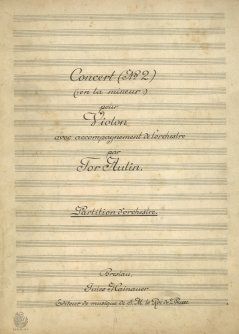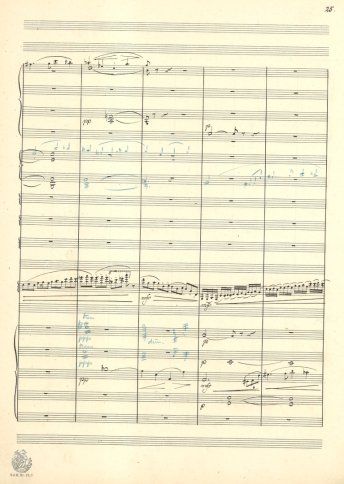Tor Aulin
Tor Aulin was born on 10 September 1866 in Stockholm (Sweden). His father, a professor for ancient Greek, died when he was only three years old. But his mother who was a trained singer fostered the musical development of the young Tor Aulin. He became a child prodigy on the violin and entered the Royal Conservatory for Music in Stockholm at the age of 11 to study under Johan Lindberg. At the age of 15 Tor Aulin got a position as violinist in the orchestra of the Dramatiska Teatern which earned the family some additional living. In 1883 the renowned French violinist Emile Sauret visited Stockholm, heard Tor Aulin play and accepted him as his student. So Tor Aulin moved to Berlin in 1884 to study under Sauret and also composition under Philipp Scharwenka until 1886.
After his studies Tor Aulin successfully toured the Northern countries as a soloist. In 1887 he founded the first Swedish string quartet, the Aulin quartet. This ensemble together with the pianist Wilhelm Stenhammar gave numerous concerts in the following years and promoted the chamber music in Sweden. Tor Aulin was also appointed concert master of several orchestras very soon, among them the Kungliga Hovkapellet in 1889, a position he held until 1902. At the turn of century Tor Aulin became more and more interested in conducting and therefore expanded the possibilities for performances in Sweden. In 1900 he formed the orchestra of the Svenska Musikerföreningens (Swedish musicians society), was co-founder of the Stockholm Concert Society in 1902 and co-founder of the Gothenburg Symphony Orchestra Society in 1905. As a conductor Tor Aulin championed the works by Franz Berwald and had the honour to premiere his third symphony "Singuliere" in 1905, which was rediscovered some years before. In his last years Tor Aulin became the principal conductor of the Gothenburg Symphony Orchestra together with Wilhelm Stenhammar. Tor Aulin died on 1 March 1914 in Saltsjöbaden (Sweden).
Tor Aulin was also active as a composer. Today he is best known for his 3rd violin concerto op.14, composed in 1896 and dedicated to the violinist Henri Marteau. This work made it into the standard repertoire of many violinists and is a frequent guest on concert stages. But his work catalogue also include two other fine violin concertos (op.7 from 1890 and op.11 from 1892), "Four Swedish dances" for orchestra, the incidental music to the play "Mäster Olof" by August Strindberg, several compositions for violin and piano among them his famous "Four aquarelles", a Serenade for string quartet, chamber music for piano solo and violin solo as well as some songs.
Violin concerto No.2
In my possession is a handwritten manuscript of the full score of the Violin concerto No.2 op.11 by Tor Aulin. The work was composed in 1892 and premiered on 14 January 1893 by Tor Aulin (violin) and Ivar Hedenblad conducting an orchestra composed of the ensemble of the Stora teatern and the Neumannska kapellet. The concerto is dedicated to the Swedish violinist Conrad Nordqvist.
Before I describe my manuscript I would like to give some words about the situation of documents of this composition that is somehow complicated.
As far as I know there are no known autograph manuscripts of the violin concerto No.2. But the piano reduction was published by Kgl. Hof-Musikhandel in Copenhagen as well as by Julius Hainauer in Breslau in 1894. For a full score the situation is poorer. Only the archive of the Swedish Radio holds a handwritten score written down by a copyist.
According to this situation another copy of a full score is a valuable document in any case. My manuscript consists of 110 pages with the full score of the second violin concerto. The score is written in ink on "B & H Nr. 12 C" paper. The title page is penned down in French and bears the bottom line "Breslau / Jules Hainauer / Editeur de musique de S. M. le Roi de Prusse". Such a title page seems to be unlikely made by Tor Aulin himself. He surely would have used Swedish or German and left the publishing house out. Beyond that a comparison to other autograph manuscripts of Tor Aulin show differences in the handwriting. So there are good reasons to believe that my manuscript was made by a copyist from the publishing house Julius Hainauer in preparation for the publication of the full score. That never happened, but it is likely that this manuscript was created shortly after the release of the piano reduction, so around 1894.
What makes this manuscript even more interesting is the fact that the score contains numerous handwritten additions in pencil and blue crayon. The changes are so extensive and significant that they can only be made by Tor Aulin himself. This include omissions of complete measures and corrections and additions of instrumental phrases. The added annotations are in German ("ruhig", "hervortretend") which also points to Tor Aulin.
Unfortunately neither the original writing in ink nor the added corrections in pencil and crayon are dated or signed. Therefore I have no evidence when, by whom and under which circumstances this revised version was really made. If one compares the two only existing manuscripts - the one in the Swedish Radio archive and mine - it becomes evident that the "Swedish Radio version" and the "original ink version" in my manuscript are nearly identical. Only almost identical because the score from the Swedish Radio calls for an orchestra without trombones, the ink version in my manuscript calls for additional 2 trombones and 1 bass trombone. This indicates that Tor Aulin had already made revisions on the score with adding trombones. The later corrections in pencil and crayon could be the continuation of this process and they are completely unknown so far.
One could point out that the version in my manuscript was the original one and the final version is the one from the Swedish Radio archive. But that wouldn't make much sense. Why should Tor Aulin prepare a full score, let it write down by a copyist, then adding so many corrections and finally leaving all these corrections and the trombones out? A more reasonable course of events goes like this:
Tor Aulin composed and finished his second violin concerto in 1892. He premiered it in January 1893. Jules Hainauer published the piano score in 1894 and was preparing the release of the full score. A copyist created a full score and sent it to Tor Aulin. The composer made several corrections in the score, maybe as a result of his impressions from the world premiere. For unknown reasons this corrected version was never published nor the revisions transferred to the other full score.
As a conclusion I think that the version in my manuscript is the revised violin concerto No.2. The work was premiered on 19 November 2022 by Fritiof Palm (violin), the Järfälla Symfoniorkester under Gunnar Julin (conductor). Please also read my short text about this performance here.


